End of an era: an oral history of Showtime’s 37 years in boxing – part 1
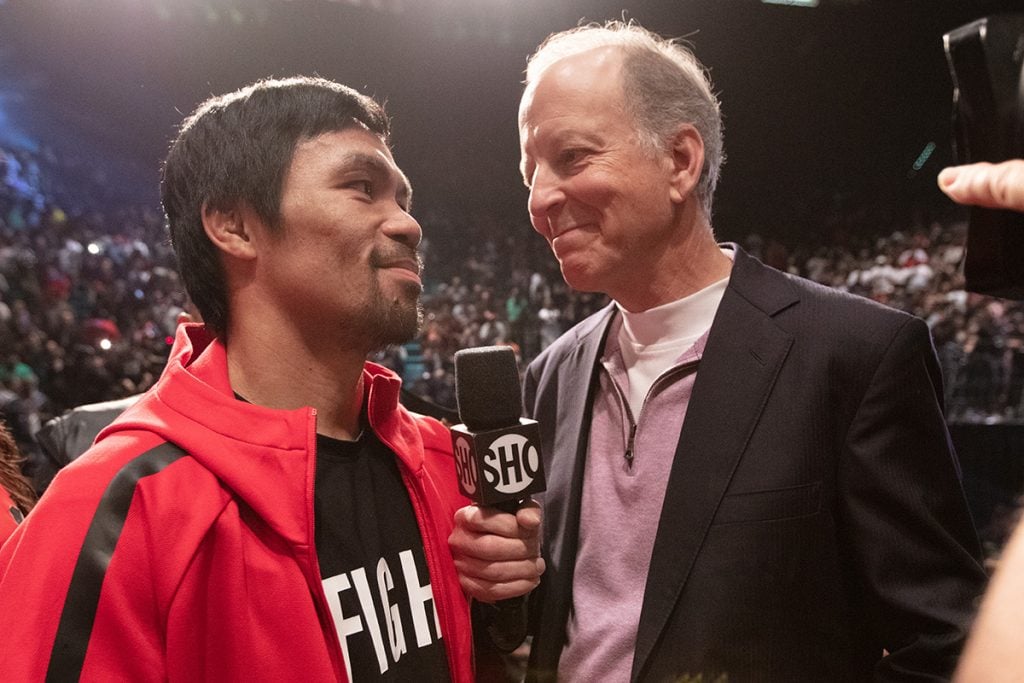
Showtime’s parent company Paramount Global decided to shut down Showtime Sports in October, thus ending the premium cable provider’s 37-year run producing boxing shows.
Showtime televised its first boxing show on March 10, 1986, and it will air its final broadcast this Saturday, on December 16, 2023.
To commemorate Showtime’s remarkable run in the sport, Ring Magazine presents to you a four-part oral history and retrospective featuring some of the key principals who helped shape the network’s coverage of boxing for nearly four decades.
Part 1
- Jim Gray, ringside reporter, International Boxing Hall of Fame inductee, 31 years with Showtime
- Al Bernstein, ringside analyst, International Boxing Hall of Fame inductee, 20 years with Showtime
- Steve Farhood, analyst, boxing historian, International Boxing Hall of Fame inductee, 22 years with Showtime
- Steve Albert, play by play announcer, 24 years with Showtime
Part 2
- Stephen Espinoza, president of sports and event programming, 12 years with Showtime
- Chris DeBlasio, senior vice president of sports and communication, 18 years with Showtime
- David Dinkins, executive producer, 37 years with Showtime
- Gordon Hall, senior vice president of production, executive producer of SHOBOX: The New Generation, 34 years with Showtime
- Sheila Mills, senior vice president, sports marketing, 36 years with Showtime
- Brian Dailey, senior vice president sports and digital, 10 years with Showtime
Part 3
- Barry Tompkins, play by play announcer, International Boxing Hall of Fame inductee, 11 years with Showtime
- Brian Custer, host, 10 years with Showtime
- Brian Campbell, ringside analyst and reporter, 5 years with Showtime
- Raul Marquez, former junior middleweight champion; SHOBOX and Spanish simulcast ringside analyst, 12 years with Showtime
- Alejandro Luna, host, Spanish simulcast play by play announcer, 12 years with Showtime
Part 4
- Robert Dunphy, director, 37 years with Showtime
- Raymond B. Smaltz III, senior producer and replay director, 36 years with Showtime
- Chuck McKean, senior associate producer and director, 32 years with Showtime
- Michael Teodoru, associate producer, 30 years with Showtime
- Colin DeFord, technical producer, 33 years with Showtime
End of an era: an oral history of Showtime’s 37 Years in boxing: Part 1
The following interviews have been edited for length and clarity.
Showtime’s final boxing broadcast marks the end of a magnificent era. What do you think set Showtime apart from others during its 37-year run in the sport?
Jim Gray, ringside reporter, International Boxing Hall of Fame inductee, 31 years with Showtime: Having been at Showtime since the very beginning, we always looked forward to the big events and getting together with great people almost once a month. We formed a terrific and unique camaraderie. In the early days, we were considered the little engine that could. HBO was the big monster on the block. We just kept plugging away and working away to become their equal and to surpass them. We had a drive and pursuit that was really special and lots of fun.
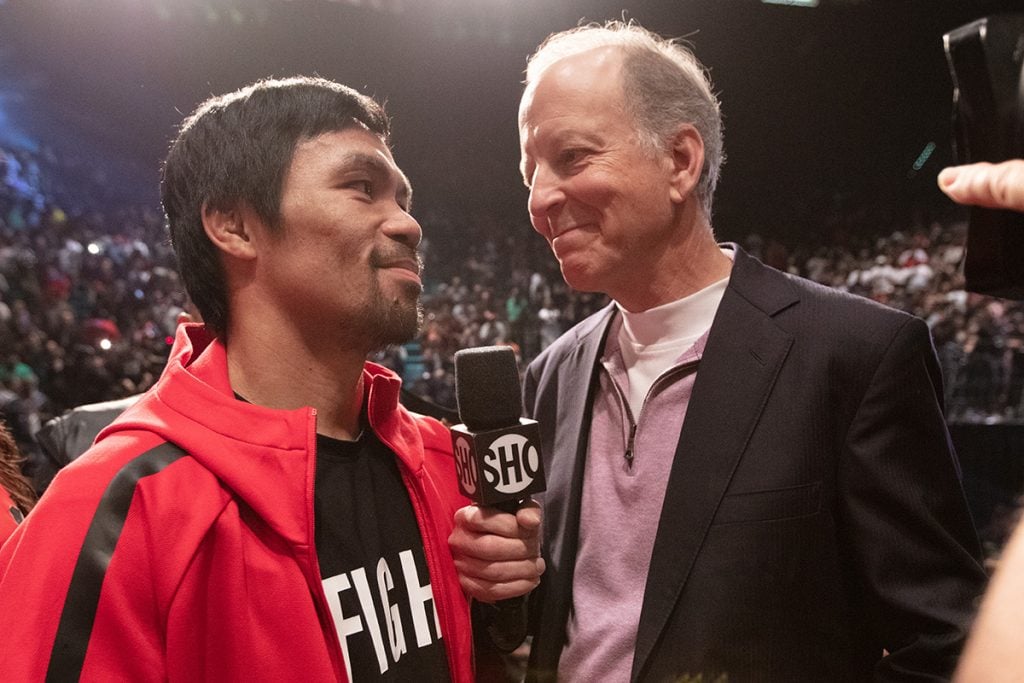
Hall of famer Jim Gray interviews future hall of famer Manny Pacquiao. Photo by Scott Hirano / Showtime
Al Bernstein, ringside analyst, International Boxing Hall of Fame inductee, 20 years with Showtime: I think our production both behind and in front of the cameras is completely focused on the fighters and the moment at hand. We don’t do a discussion program and we don’t discuss the fights – we provide information and insights related to the fight in front of us. And I believe our production is nimble in following any changing storylines.
Steve Farhood, analyst, boxing historian, International Boxing Hall of Fame inductee, 22 years with Showtime: The quality and consistency of the production were key elements for sure, but there were some subtle things as well. For one, unlike some other networks, Showtime always gave the B-side of a fight his or her just due. Let’s face it – some fights are clear showcases, but rarely if ever did the producer or announcers approach a fight with a political agenda or preconceived notions. One other factor Showtime took full advantage of was no commercials. As a result, we were free to examine the storylines that so often played out between rounds.
Steve Albert, play by play announcer, 24 years with Showtime: To me, it was all about great fighters and great fights. Showtime put us on the national stage calling some of the most high-profile fights in ring history. I got to call over 300 world championship matches during my 23 years with the network. This was from 1987 to 2011, a sparkling era for the sport.
For decades, we traveled to exotic cities where so many of our mega-fights took place. We broadcast in front of an ancient castle in Wales, the world-famous Plaza del Toros bull ring, Wembley Stadium in England, and numerous shows from the Mecca of Boxing, Madison Square Garden. Hometown fights were invigorating and Showtime brought many into America’s homes. The atmosphere was electric. The fans were so invested when they had a strong rooting interest. Simply put, it was compelling television and the energy certainly inspired us at ringside.
Saturday nights on Showtime were packed with drama. Through the years, the sport has been romanticized and dramatized. While our on-camera opens may have been scripted, everything after that was true unscripted reality TV and that was a huge part of the allure.
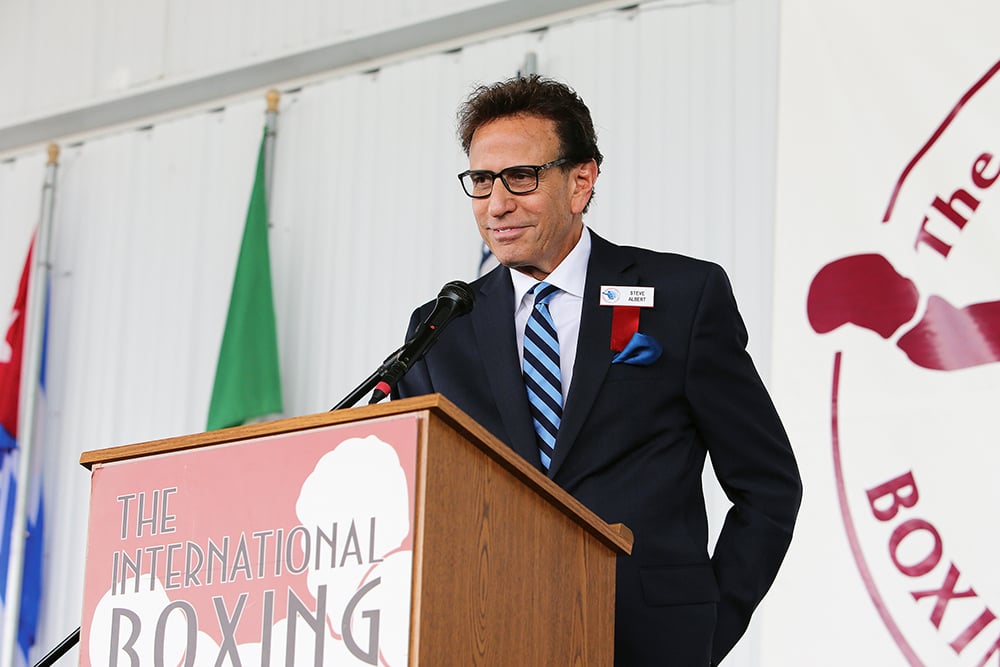
Steve Albert gives his induction speech at the International Boxing Hall of Fame. (Photo by Alex Menendez/Getty Images)
How would you like Showtime’s legacy to be remembered by sports fans and the boxing community?
Jim Gray: Showtime Boxing was for the people, for the fans, and for the fighters. We presented boxing in a fashion that was honorable to the sport.
Al Bernstein: As a show that presented exciting boxing fairly and effectively.
Steve Farhood: Well, 37 years is a long time, and since the medium is the message, Showtime became a significant part of the fabric of boxing. Also, the range of fights covered the full spectrum, with everything from relatively low-profile ShoBox matchups between prospects to the biggest fights the sport could offer. Boxing is a star-driven sport, and Showtime regularly featured the biggest stars, most notably Mike Tyson and Floyd Mayweather Jr.
Can you share one of your favorite stories, anecdotes, or experiences that you were involved in while working a Showtime Boxing event?
Jim Gray: From the bite fight to Mike Tyson telling me he broke his back – spinal – to Tyson saying he would eat Lennox Lewis’ children and to more recently when Danny Garcia talked about mental health issues and cried, there are so many, and it’s hard to nail one down.
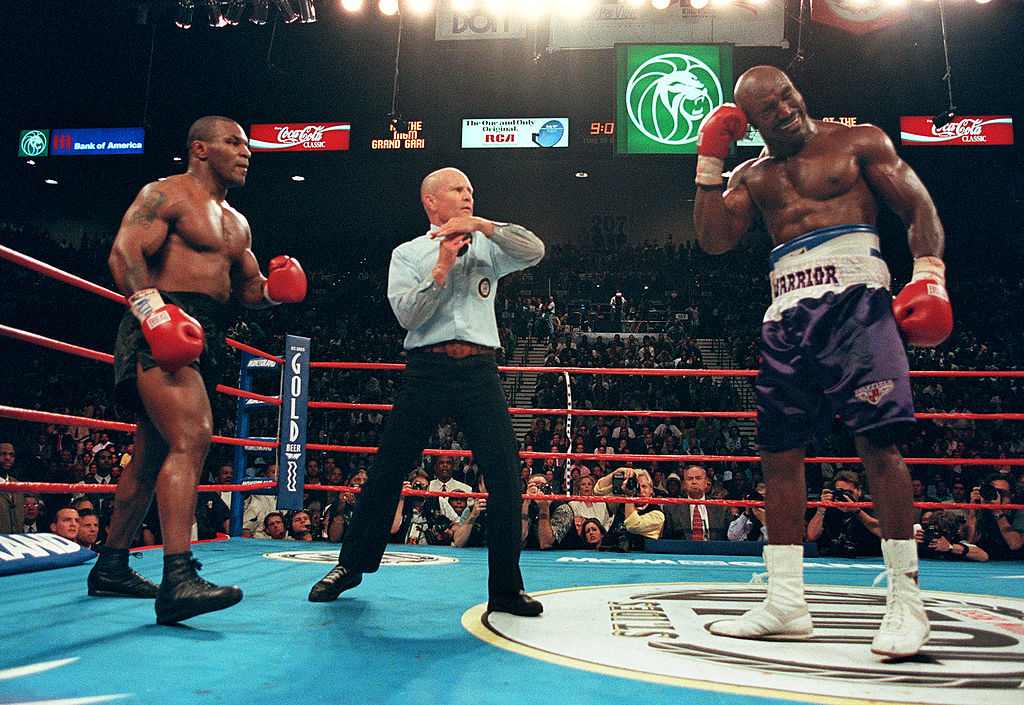
The infamous “Bite Fight,” the rematch between Evander Holyfield and Mike Tyson was a Showtime production. Jim Gray was able to interview the disqualified Tyson outside of his dressing room following the bizarre event. Photo by JEFF HAYNES/ AFP via Getty Images
Al Bernstein: During the first Juan Manuel Lopez vs Orlando Salido fight in 2011, Lopez was the hometown hero and he lost when the fight was stopped – possibly prematurely. The crowd started throwing things into the ring. I got hit with a full water bottle about a half-inch above my right eye. I was cut and dazed. Gus Johnson announced on the air “my partner has been hit.” I took my headset off and took about a one-minute break, then continued. So, I was not stopped on cuts.
Steve Farhood: Three quick ones: First, about an hour after Holyfield-Tyson II, my longtime colleague Nigel Collins and I walked into the lobby of the MGM Grand. Scattered across the floor were motionless bodies. I asked a security guard, “Are those people dead?” He answered, “No, they were trampled.” When all hell broke loose in the casino, there was panic and a mass exodus. I’ll never forget that scene.
Second, in 1992, at the Hilton in Las Vegas, I worked as reporter and third man for a show featuring Hector Camacho. I conducted a taped outdoor interview with “The Macho Man” on the day of the fight, and when he arrived, he was wearing a bright red fire captain’s hat. Instead of answering my questions, he kept looking toward the roof and shouting about a fire. After a while, I found myself looking up, too. There was no fire, of course. Trust me – nothing in journalism school prepared me for an interview with Hector Camacho.
Third, in 2005, at Foxwoods in Connecticut, we worked a ShoBox fight involving a lightweight named Al “Speedy” Gonzalez. Paulie Malignaggi, then a rising contender, told me beforehand that he wanted a fight with Gonzalez. So we planned for Paulie to rush the ring after Gonzalez’s fight, and I gave a heads-up to our director about what Paulie was going to do so our cameras would be ready. So the fight ended and Paulie rushed to the ring. Security guards quickly surrounded him and escorted him from the arena. My broadcast partner Nick Charles called it this way: “Paulie is going, going … gone!” Only the work of some influential people prevented Paulie from being arrested.
Steve Albert: A good portion of my two-plus decades at Showtime saw the one and only Don King promoting our fights. I don’t know where to begin in depicting Don but perhaps this personal experience will help.
The night before my Hall of Fame induction ceremony, inductees along with several guest speakers each got up to say a few words at a gala. One of the guest speakers was Don King, who was famous for his lengthy soliloquies. Mike Tyson shared the stage along with other inductees and luminaries.
Mike and Don had a history of issues, primarily involving money. These issues were unresolved, apparently. After Don completed his speech, he went back to the dais and took his seat next to Mike Tyson at which point Iron Mike flung his beverage right into the face of Don King.
Often, I found myself shaking my head at the things I encountered and would repeatedly say, on and off the air, “Only in boxing, folks, only in boxing.”
On December 9, 1995, a ring riot erupted in Stuttgart during a showdown between hometown hero Axel Schulz and South Africa’s Francois Botha for the vacant IBF heavyweight crown. This was a day I’ll always remember for a variety of reasons.
This was “Listerine Bottle Night” in Stuttgart. They handed out complimentary bottles of Listerine mouthwash to the 11,000 fans who entered the arena. The bottles, thank goodness, were made out of plastic, not glass, which figures into what’s coming soon.
When Ferdie Pacheco and I finally got around to announcing the main event, the unbeaten Botha of South Africa won a controversial split decision over the German Schulz. When the decision was announced, the fans were enraged. And then a tsunami of Listerine came flying down. Fans were also jettisoning beer, wine, and champagne bottles toward the ring. They threw some coins in for good measure.
Then came those “comforting” words in my headset from producer David Dinkins to get under the table, as these projectiles were zinging around me like heat-seeking missiles. My head was making for a perfect target.
Stage manager Joel Farbstein was standing by my side, deflecting bottles and coins from hitting me. A female spectator just off to my right was lying on the floor with blood oozing from her head.
Then there was British heavyweight Julius Francis in Manchester, England. Francis had no chance against Mike Tyson and he probably figured, hey, why not capitalize on the situation? To nobody’s surprise, Francis was decked five times in the first two rounds. Iron Mike put him flat on his back in the second round and as he was being counted out by the referee, it was hard not to notice that emblazoned on the soles of Francis’ shoes were the words, “Buy the London Daily Mirror.” I can only suppose that the next day, newspaper sales in London skyrocketed.
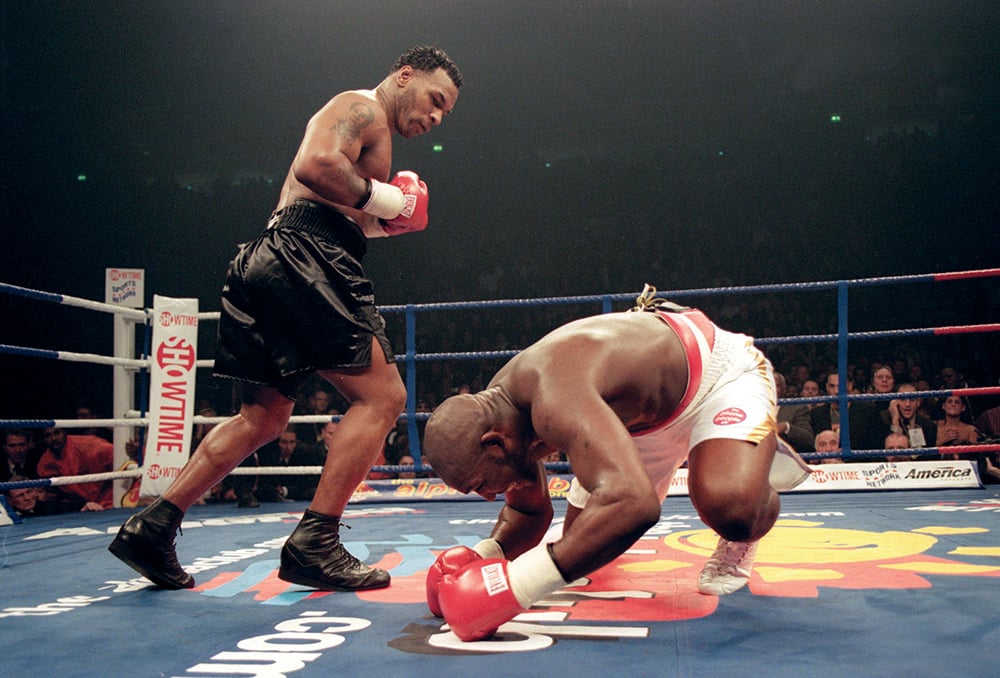
Mike Tyson vs. Julius Francis.
(Photo by John Gichigi /Allsport)
Last but not least, I bring you the story of journeyman Sam Adkins, a burly 6 foot 3 heavyweight who once fought on a Showtime undercard in 1993 but didn’t make the television broadcast. Only a few diehard early-bird fans in the stands saw Sam going against a behemoth out of Nigeria named King Ipitan.
I wasn’t paying much attention to this preliminary bout as I was sitting ringside making final preparations for the televised event. I prided myself on thorough preparation. In addition to researching the fighters, I often wrote reams of notes, or ad-libs as I jokingly called them, on legal pads with a felt-tipped pen. At each fight show, I would place these notes carefully on the broadcast table amidst a maze of wires, cables, and TV monitors. I would also very precisely line up my bevy of beverages closest to the ring apron. It consisted of a cup of coffee, a cup of water, and a cup of soda. I covered each cup with an index card so that blood from the fighters wouldn’t spill into them.
Anyway, while I was gingerly and skillfully arranging all of these precious items on the table, I saw, out of the corner of my eye, Ipitan landing a monstrous haymaker on Adkins knocking Sam clear through the ropes directly above me. His fall took down the TV monitors, wires, cables, and all three of my delicately placed beverages. The index cards on top of my drinks flipped in the air and the flying liquid from these cups drenched my notes. The ink on the notes began to dissolve, turning words into watercolor blobs, rendering them virtually useless and unreadable. I had spent weeks preparing those notes. My vital tools for broadcasting the entire show were obliterated, just like that.
As Sam continued to slide down, destroying everything in his path, like Godzilla in Tokyo, he landed right in my lap before descending further to the cold, hard concrete floor. There’s Adkins, sprawled out, completely dazed but looking straight into my forlorn eyes.
What else could I do but say to him, “Well Sam, you’ve just ruined two careers. Yours and mine.” He smiled, struggled to his feet, and lost by disqualification in the final fight of a 2-7 career.
By the way, a few minutes after this memorable scenario, one of the Showtime production assistants rushed out to ringside with a portable hair blower. We plugged it in and were able to salvage most of my notes.
He never even made the live broadcast, but the image of Sam Adkins is indelibly etched in my mind, not to mention, my lap.
Only in boxing, folks, only in boxing.
Showtime staged and showcased countless memorable matchups. Which are your three favorite Showtime Boxing fights that you were involved with?
Jim Gray: Diego Corrales vs. Jose Luis Castillo I was the greatest fight I’d ever seen. Corrales told me afterward, “This fight was an honor.” It was one of the greatest answers to one of the greatest fights I’d ever seen. It was an honor to cover it. I remember leaving afterward with Steve Albert just trying to find a T-shirt or a program, and I’d never done that before. But that’s how great the fight was.
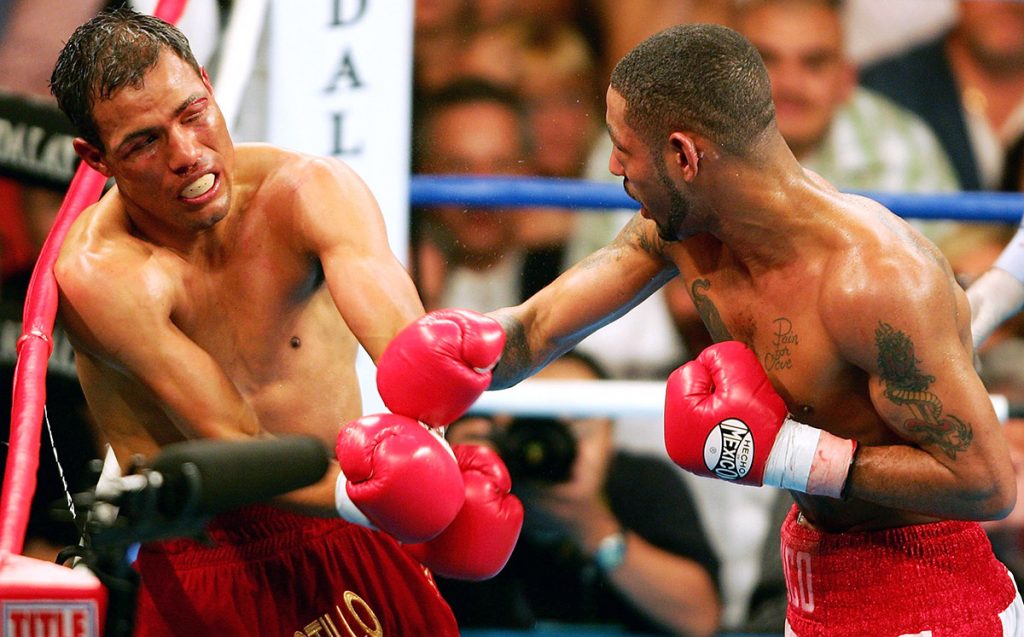
The final seconds of Corrales vs. Castillo I, arguably the greatest fight of the modern era. (Photo by Nick Laham/Getty Images)
Tyson-Holyfield II was also special because I won an Emmy Award for my interview.
Watching Tyson Fury get up like he was Frankenstein in the first fight versus Deontay Wilder in 2018 was also memorable. It was phenomenal that he was able to get up. It was an incredible feat by a human being. It set-up a great trilogy.
Al Bernstein: Diego Corrales vs. Jose Luis Castillo I; Israel Vazquez vs. Rafael Marquez IIIl; Ricky Hatton-Kostya Tszyu.
Steve Farhood: I’ll group two fights together – Ricky Hatton vs. Kostya Tszyu in Manchester, England, and Anthony Joshua vs. Wladimir Klitschko at Wembley in London. Suffice it to say Tszyu and Klitschko didn’t have too many supporters at these fights. At both, the atmosphere was breathtaking.
On ShoBox, we had a ton of memorable one-round fights, but the one that stands out was a battle of unbeatens, Sechew Powell vs. Cornelius Bundrage in 2005. The fighters landed their first punches, producing a double-knockdown, and then, with the third punch of the fight, Powell knocked out Bundrage. The whole thing lasted 22 seconds.
Ironically, Powell-Bundrage I, which was arguably ShoBox’s most unforgettable fight, happened the night before Corrales-Castillo I, which was inarguably the best fight in the network’s history.
Steve Albert: By and large, Showtime aired major marquee fights, but they did not come much bigger than Holyfield-Tyson II on June 28, 1997. It was enormous, particularly following Holyfield’s stunning upset victory in the first fight, a riveting 11th-round technical knockout victory. That stirring win propelled Holyfield into legendary status.
On the night of the rematch, I had more butterflies than usual. I was always uneasy before calling a Mike Tyson fight. You just never knew what to expect from the guy. He was so unpredictable. Generally, for any fight, I would prepare scrupulously. I would research each fighter’s background, study tapes, talk to as many people as possible and gather as much information as I could. I always prepared extensive notes. For each broadcast, I may only refer to about ten percent of my notes, but it made me feel better psychologically to be well-prepared.
Tyson fights were usually disruptive. They often upended any broadcasting plans I had and opened me up to potential verbal fumbles. Accordingly, that night, despite my thorough preparation, the butterflies were doing gymnastics in my stomach.
I remember thinking to myself that Tyson was going to do something strange that night. It was probably based more on experience than premonition as I had witnessed many other wild and crazy things he had done in the ring. Maybe it was nerves, but I also had this sinking feeling in my gut that he was going to pull something exceedingly out of the ordinary.
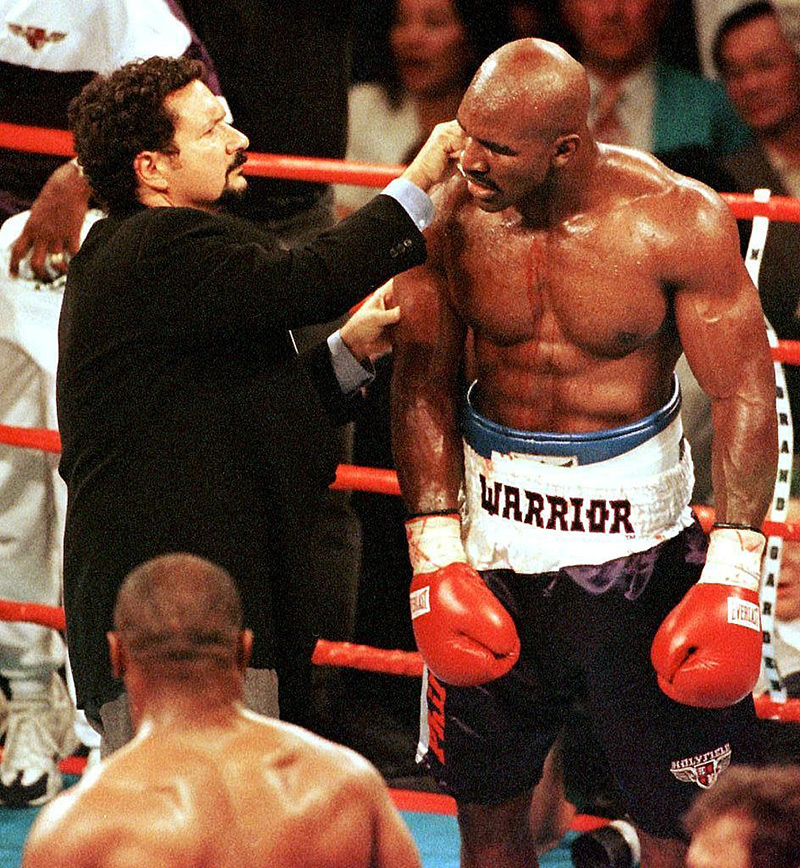
Ringside doctor Flip Homansky tends to Evander Holyfield during the infamous “Bite Fight.” Photo by Mike Nelson / AFP / Getty Images
As it turned out, nobody could have foreseen what happened in what is now known as the “Bite Fight” when Tyson bit Holyfield’s ear and was disqualified.
Amid all this confusion and craziness, I tried to keep my cool. Not only was there bedlam in the ring but the crowd around me had also gone berserk. While the circumstances grew even more chaotic, I reminded myself to just describe what was going on, as a reporter would.
I managed to get through this debacle and subsequently the broadcast, but everybody involved at ringside was visibly shaken.
Following the telecast, I couldn’t wait to get out of there and return to the sanctity of my room. I needed to find some peace. As soon as we dropped the microphones, I was history.
To this day, I have never seen a replay of the telecast. I called it, but I never watched it. I’m not exactly sure why. Perhaps I’m still repulsed by the notion of somebody biting off a chunk of someone else’s ear. Maybe it’s that I’m still beating myself up because I didn’t see it happen instantaneously, not able to report it immediately to viewers.
This much I know for sure. It was undoubtedly the most memorable and challenging night of my broadcasting career.
* * *
We remember most fights because of what happened inside the ring. In the case of Julio Cesar Chavez vs. Greg Haugen on February 20, 1993, it’s what occurred outside the ring that was truly remarkable.
I had never seen that many people in one place at the same time – 132,247 spectators at the Azteca Stadium in Mexico City, Mexico. It was mind-blowing to look out over this sea of humanity, and all to see one man beat the crap out of another man.
To call this outdoor arena cavernous is an understatement. It felt like they could fit five Yankee Stadiums inside of it. Normally, it was used as a soccer venue. On this night, it was home to El Gran Campion, who ended up scoring a fifth-round stoppage win.
I always suspected that Don King’s strategy for this fight was more promotion than anything else. He may have even encouraged the American Haugen to fill the seats by insulting the hometown champion to rile up the local fans.
As I looked around from my broadcast table at ringside, it was surreal. There’s no other way to describe it.
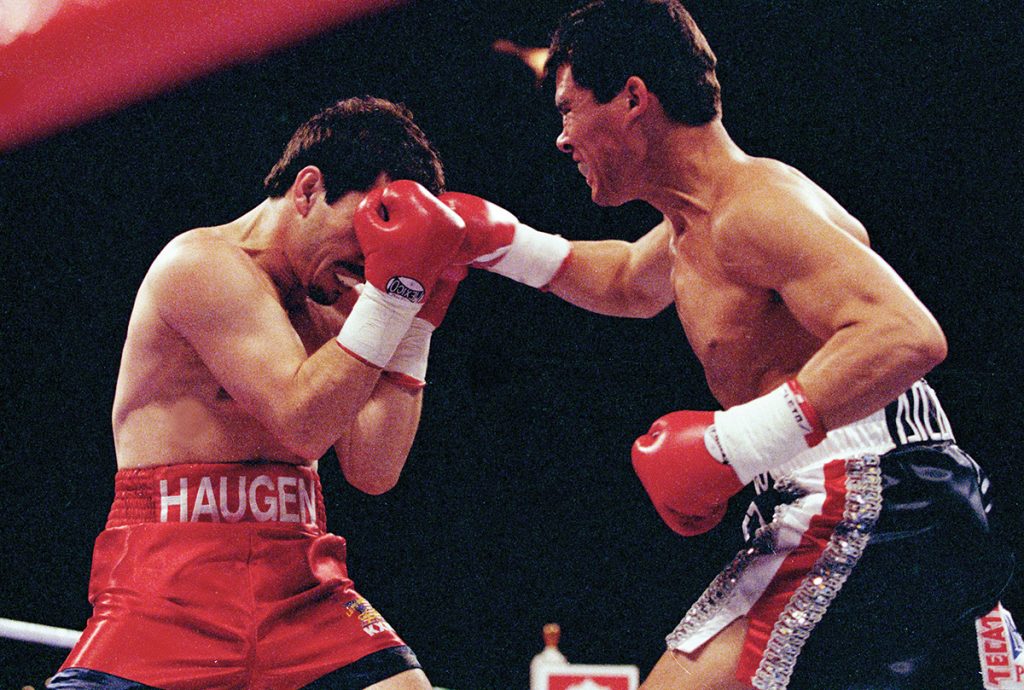
Julio Chavez wasted no time in tearing Greg Haugen apart in front of a world record stadium crowd. (Photo by Holly Stein/Allsport)
* * *
Of the 300-plus world championship fights I announced on Showtime, one stands out as the most exciting and dramatic, however. It was Diego “Chico” Corrales vs. Jose Luis Castillo to unify the WBC and WBO lightweight titles on May 7, 2005.
In all my years of broadcasting boxing, it was unquestionably the most compelling prizefight I ever had the privilege of describing. It was one of the most breathtaking and heart-pounding battles in boxing history. Some of the pundits went as far as saying it was the greatest fight of all time.
Adding even more clout to that contest was that it took place on the weekend of the annual Boxing Writers Association of America dinner in Sin City. It received more coverage than usual since there were so many media members in attendance.
There was phenomenal back-and-forth action throughout. It was non-stop. Neither fighter would budge an inch. The crowd was into the action right from the opening bell. Each round was gripping. Everybody seemed locked in, meaning the combatants, the crowd, and all of us at ringside. It was ten rounds of sheer mayhem. Both guys gave and took some hellacious shots. And of course, Corrales scored the dramatic come-from-behind knockout win.
I saw it firsthand and still cannot believe what happened. To be there, to witness that event live was about as electrifying as it gets in the sport of boxing. To be the one calling it on television? It’s difficult to describe how exhilarating that was.
A fight like that happens only once in a lifetime and I was lucky enough to call it.
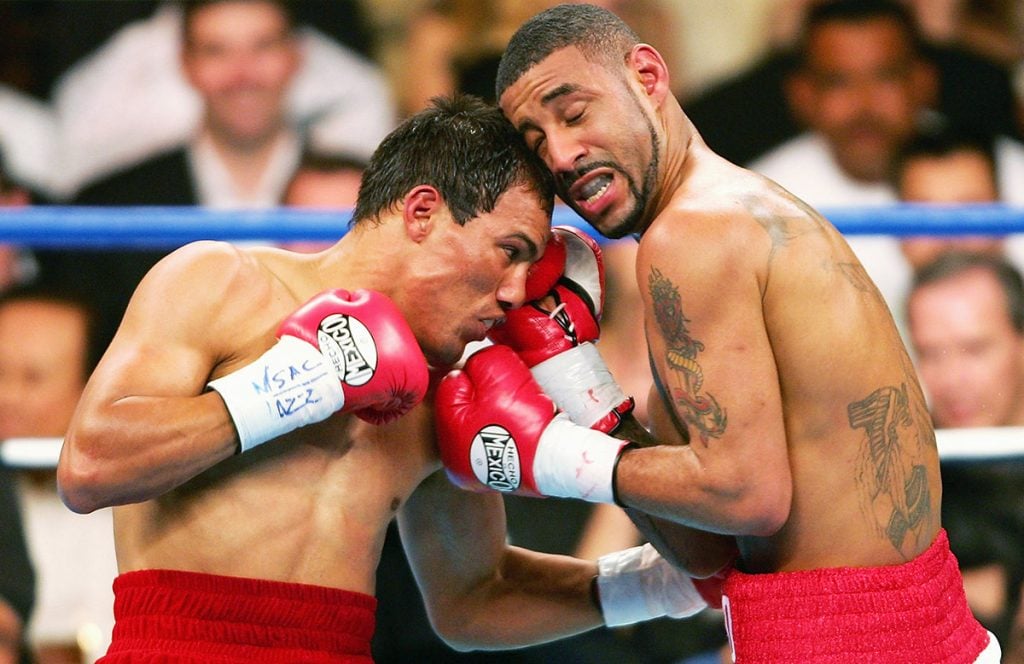
Corrales-Castillo I created drama that will likely never be surpassed in a prize ring. (Photo by Nick Laham/Getty Images).
The promotion leading up to a fight, the week of, and the immediate aftermath offer many unforgettable moments. What stands out to you as the most revealing behind-the-scenes moment that you experienced during a Showtime Boxing fight?
Jim Gray: Jimmy Lennon Jr. introduced luminaries during a fight in the late 1990s. Muhammad Ali and Joe Frazier stepped into the ring. I was in the ring as well, and after Ali struggled to get up the stairs, Frazier came up to me and said, “Who do you think won the fights now, Jim?” That was shocking, alarming, and poignant, and showed the level of rivalry that existed between them until the end of their lives.
Al Bernstein: To me, it is the many fighter meetings we’ve had over the years. They were often humorous, sometimes poignant, and occasionally combative. I have loved interviewing the boxers over my whole career.
Steve Farhood: A promotion and production like no other was Floyd Mayweather Jr. vs. Manny Pacquiao in 2015. It was quite odd working side by side with HBO’s team, which partnered with Showtime to produce the record-setting PPV show. Everything from sharing the fighter meetings with Jim Lampley and Max Kellerman to scoring along with Harold Lederman was somewhat surreal. The fight, of course, was a disappointment, but the event was bigger than I could ever have imagined.
Steve Albert: Hours before a 2003 broadcast with Steve Farhood in Scotland featuring Scott Harrison vs. Wayne McCullough, I had chomped on a cookie and a tooth fell out. It was too late to go to a dentist to have it repaired, so I simply applied some denture adhesive that my dentist had given me in case something like this ever happened on the road. I should also point out that the tooth that fell out was from the front of my mouth, so you couldn’t miss it. I applied the dental glue and made the tooth stick as tightly as I possibly could. Then I prayed to the television Gods. Just before we hit the air, I informed Steve of my little mishap. We received our cue to open the broadcast. Just as I turned to Steve to ask him the first question, wouldn’t you know it, that irksome tooth came loose again.
At this point, I’m trying to angle the front of my face away from the camera to hide this ridiculous gap in my mouth. To make matters worse, while Steve is answering my question, I’m manipulating the tooth with my tongue to try and put it back in its place. While all this is happening, Steve, very much aware of the situation, is trying to keep a straight face and not burst out in laughter. He continued to answer the question without so much as a grin, and when he was finished, somehow simultaneously I was able, with my tongue, to flip that tooth right side up and back where it belonged, then turn face front toward the camera.
To this day, I have no idea how I managed to do that. I’m just glad I did. We got off camera to go to the tale of the tape for the first fight and I was home free. The fact that Steve was able to keep it together while he was standing that close to me, watching my tongue and tooth gymnastics, all the while trying to answer a question on national TV, made him eminently qualified for the International Boxing Hall of Fame.
Who is your favorite fighter that you enjoyed covering and working with at Showtime Boxing and why?
Jim Gray: Overall, of all time, it’s Muhammad Ali. On Showtime, it’s Mike Tyson and Floyd Mayweather Jr. Tyson and I had a professional connection. He was very unique and very respectful and respected the fact that we were doing our jobs. He came to the production meetings and sat through the questions. He was always available. I appreciated the fact that we had access to him. He wasn’t hiding behind anyone. If he did anything wrong, he was there to talk about his behavior. He’s the most honest athlete I’ve ever covered. Now, you may not like the things that he did, and I don’t condone his bad behavior, but I admire how he answered questions. He threatened to kill me one day and kissed me on the cheek 20 seconds later. It’s still hard to determine which one is more disturbing. He also inducted me into the International Boxing Hall of Fame and was respectful to my father, and I’ll always be grateful for that. He called me his most trusted friend. That’s all because of a professional relationship that became a personal relationship through the years with Showtime. I’m truly grateful for all of those great indelible moments with him during my interviews. You just can’t make it up. They talked about those interviews until today.
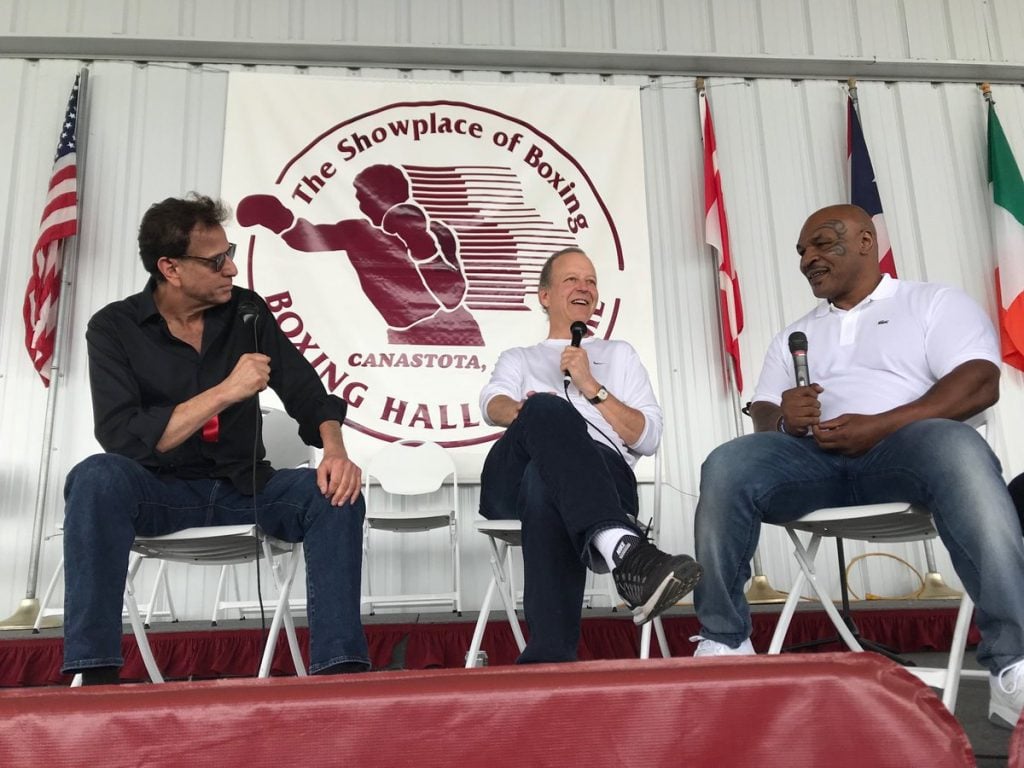
(From left to right) Steve Albert, Jim Gray and Mike Tyson. Image courtesy of IBHOF on Twitter
Floyd was at the peak of his powers when he left HBO for Showtime. He lifted Showtime to even greater heights with his pay-per-view success. He was terrific in the ring. He responded favorably to doing interviews and never ducked or avoided anything. He made it fun in the process. One time, I was supposed to interview him at his home in Las Vegas at 4 p.m. for a post-fight episode of “All Access” following the Pacquaio fight. I had a commitment in Boston with Tom Brady the next day and needed to catch an overnight flight. But Floyd was late and eventually pushed it until midnight – but with a promise. To help matters, he offered me his private jet to fly me to Boston to make it in time for my commitment. His pilots came to my interview with Tom and then flew me back to Los Angeles. He arranged everything. Everything Floyd said he was going to do, he did, and that eight-hour period encapsulates my experience with him.
Al Bernstein: I try not to have favorites, but many have been a joy to know and deal with.
Steve Farhood: I’d answer Raul Marquez, but I guess he doesn’t count because he was retired as a boxer by the time he joined Showtime’s announce team. Ishe Smith is up there; he came to symbolize the ShoBox experience. Andre Ward, John Molina and Jeff Fenech are some of the others.
Steve Albert: There were so many favorite fighters that I covered through the years but one guy stands out to me – Azumah Nelson. “The Professor,” as he was aptly nicknamed, is arguably the greatest fighter to come out of Africa. He came from the boxing hotbed of Accra, Ghana which produced so many terrific fighters.
I had the privilege of announcing several of Nelson’s fights. You could always count on his bouts being entertaining. He had an incredible heart in the ring. He also brought amazing grit and a rock-solid chin. When you factor in his experience, he was a boxing fan’s delight, not to mention a blow-by-blow announcer’s dream. Whenever Nelson fought, we were guaranteed magnificent action. He was a great TV fighter and we were fortunate he was on Showtime.
How do you see the future of boxing evolving without Showtime’s presence? What do you think the future of boxing programming and distribution will look like moving forward?
Jim Gray: It’s a shame Showtime Sports is shutting down. Boxing will find its way and continue to flourish. There are great fighters who will put together great fights and it will be picked up. It won’t be the same perspective for the people of my generation and era. But life goes on; boxing goes on. It marks the end of an era, but it doesn’t mark the end of boxing. Boxing’s greatness is in its future.
Al Bernstein: The one thing that we can rely on in boxing, TV, and everything else is that change is inevitable. So, the platforms presenting boxing are evolving and have been in recent years. We now have both broadcast and digital platforms providing the sport to fans. That will certainly continue. What percentage each will have is an open question.
Steve Farhood: The obvious answer is a further shift away from television and toward streaming. Regardless, here’s a problem that remains: Boxing is the only major sport that takes its biggest stars and events and exposes them to the fewest people. And that is unlikely to change any time soon.
SUBSCRIBE NOW (CLICK HERE – JUST $1.99 PER MONTH) TO READ THE LATEST ISSUE
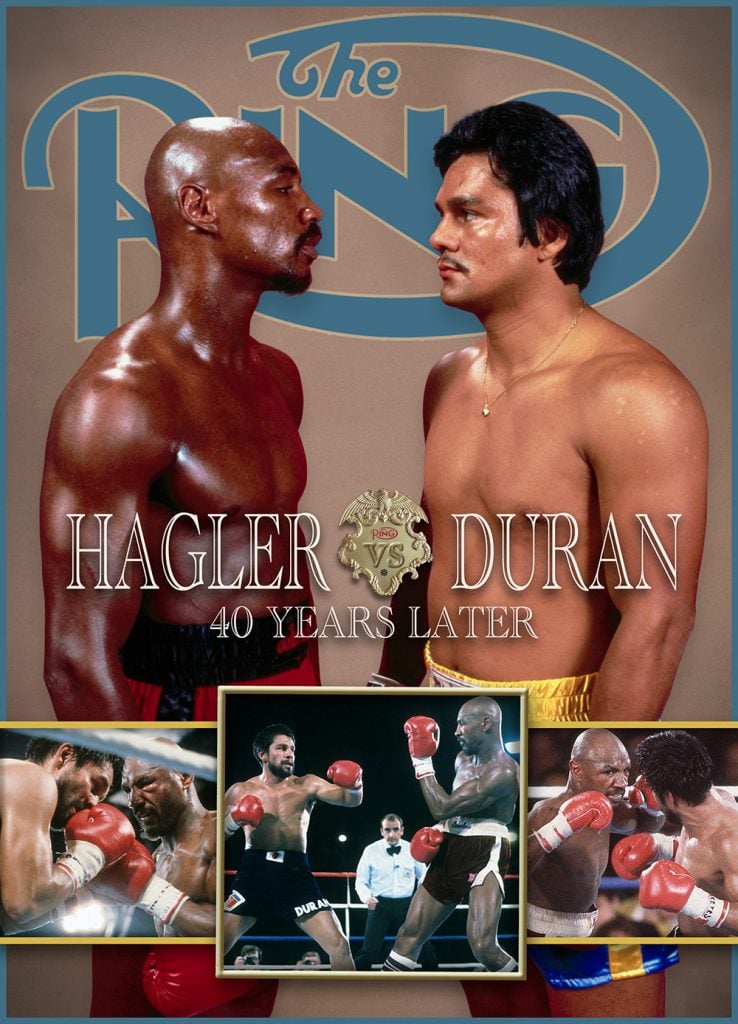


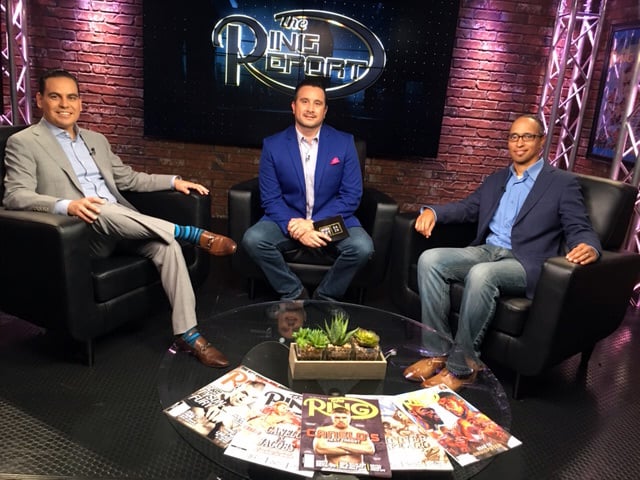
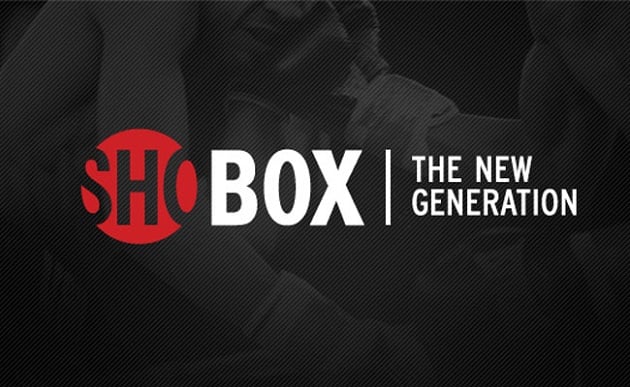
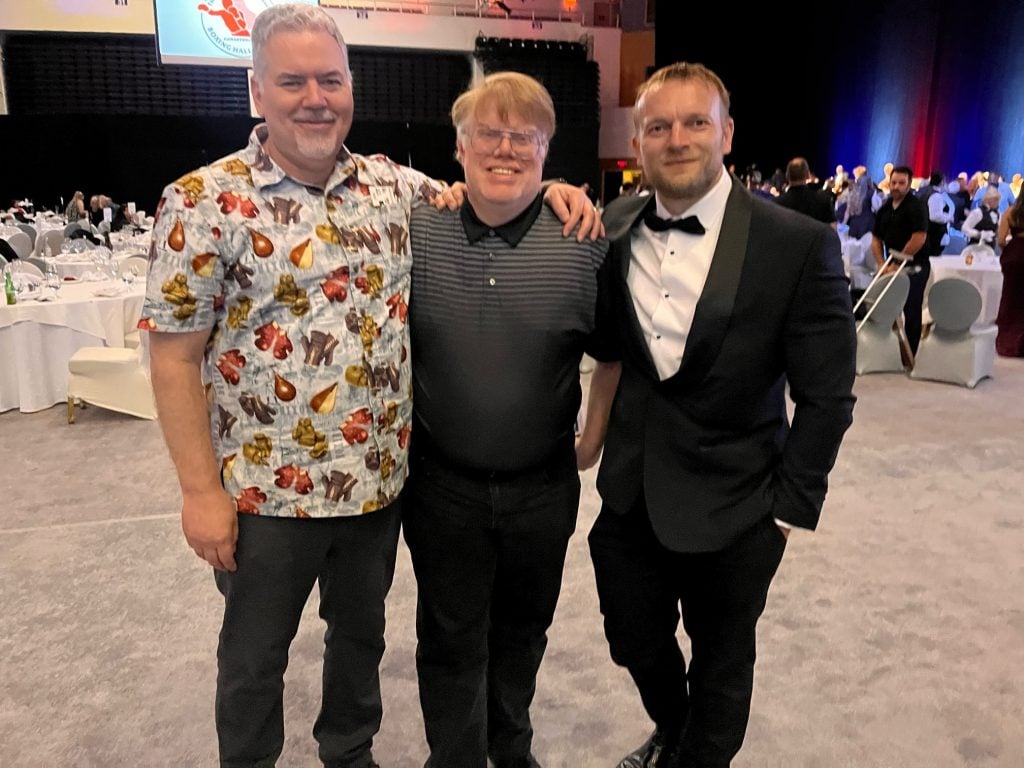
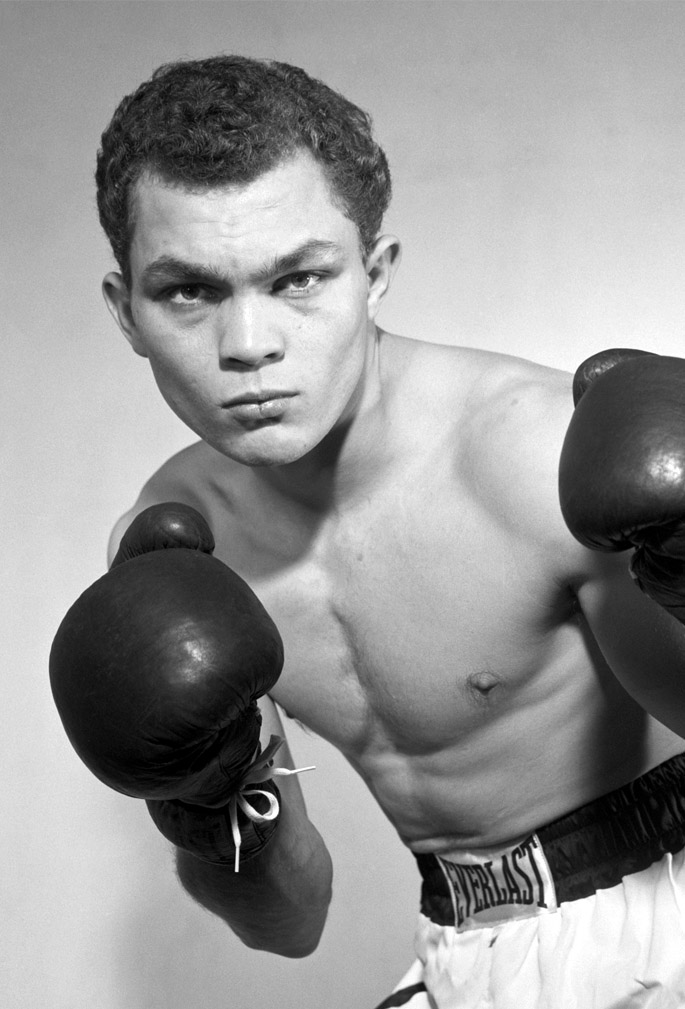
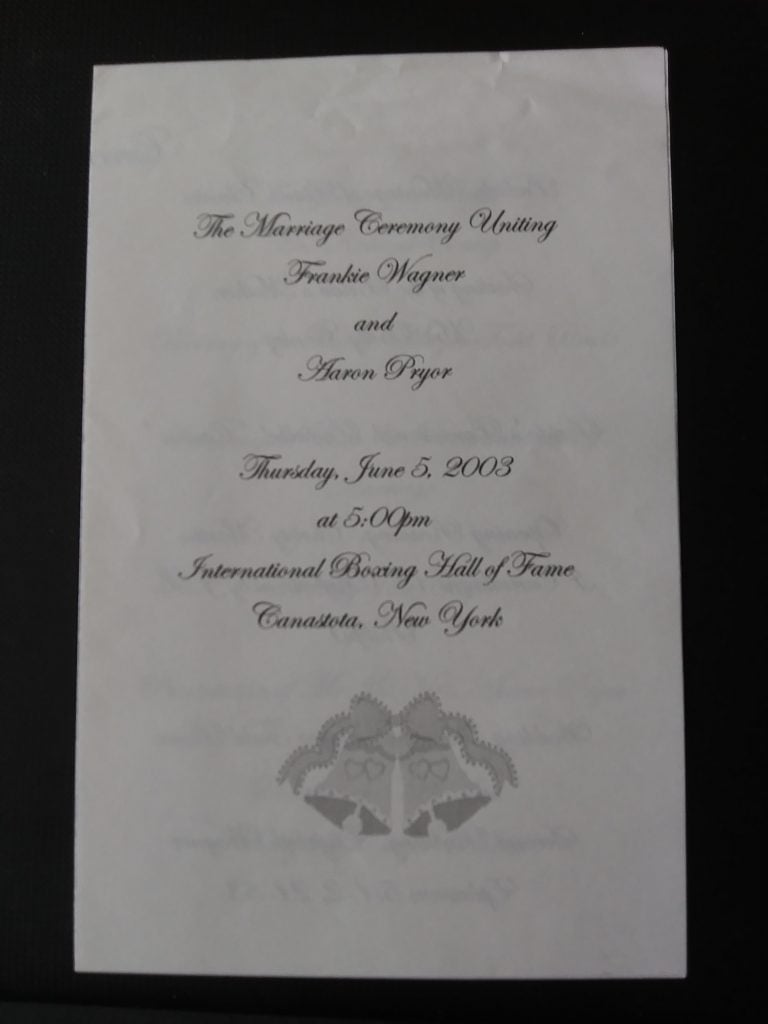
Responses